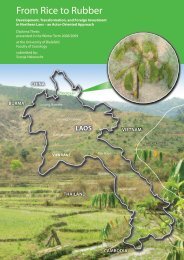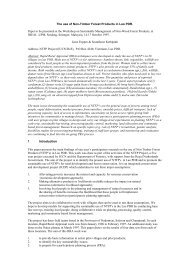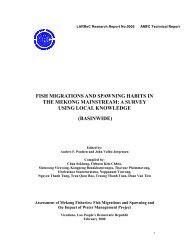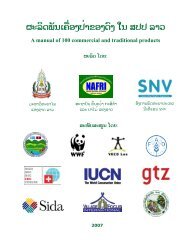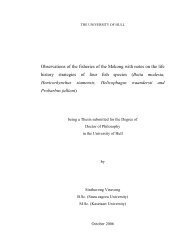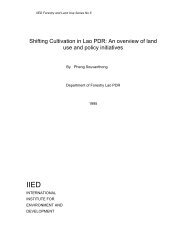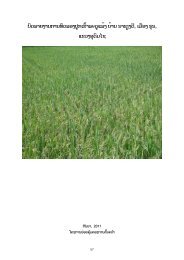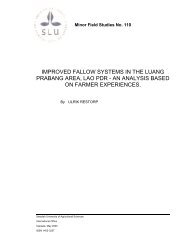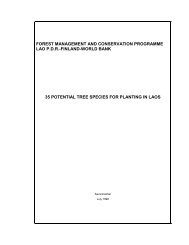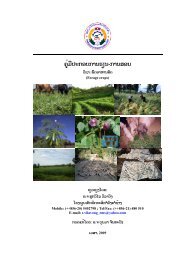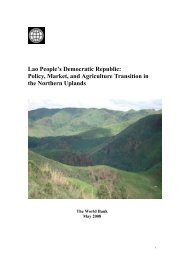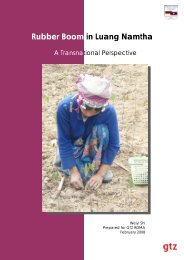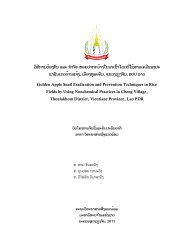Orchids trade study final version - LAD
Orchids trade study final version - LAD
Orchids trade study final version - LAD
You also want an ePaper? Increase the reach of your titles
YUMPU automatically turns print PDFs into web optimized ePapers that Google loves.
Dendrobium Lamyaiae, endemic endangered specie from Phu Khao Khouay National park<br />
1
<strong>Orchids</strong> <strong>trade</strong> <strong>study</strong><br />
Laos<br />
2009<br />
2
Growing dedrobium in Lak sao district<br />
Summary<br />
I. Trade <strong>study</strong><br />
1. Introduction<br />
2. Methodology<br />
3. Actual market chain for <strong>Orchids</strong> in Laos<br />
4. Illegal botanical Orchid <strong>trade</strong> estimation value in Laos<br />
II. Impact<br />
III. Proposal<br />
5. Orchid <strong>trade</strong> description in different province<br />
6. Conclusion<br />
4.1 Xiengkhouang province<br />
4.2 Champassak Province<br />
4.3Vientiane Province<br />
4.4 Oudomxai province<br />
4.5 Savannakhet province<br />
4.6 Thakek province<br />
3
Acronyms<br />
CITES<br />
IUCN<br />
MAF<br />
NBCA<br />
NTFP<br />
NUoL<br />
SME<br />
SUFORD<br />
Convention of International Trade in Endangered Species<br />
International Union for the Conservation of Nature<br />
Ministry of Forestry<br />
National Biodiversity Conservation Area<br />
Non Timber Forest Product<br />
National University of Laos<br />
Small & Medium Enterprise<br />
Sustainable Forest development<br />
This modest report is the result, for a big part of our own experiences and investigations.<br />
This <strong>study</strong> would show the importance of the orchid harvesting and illegal <strong>trade</strong> all around the<br />
country.<br />
I. Trade <strong>study</strong><br />
1. Introduction<br />
NTFP play an important role in the livehood, culture and traditions of Lao people. NTFP<br />
provide protein, calories, and material for construction, handicrafts, traditional medicine and<br />
cash income.<br />
NTFP also play an important role in National development. Lao PDR produce NTFP with a<br />
commercial value of 7-8 million dollars a year.The Gov of the Lao PDR recognises the<br />
potential of NTFP in contributing to poverty eradication and national development. The Lao<br />
Forestry Strategy to the year 2020 places great importance on the role of NTFP in rural and<br />
National economy.<br />
<strong>Orchids</strong> are a commercial NTFP for direct income.<br />
In Lao PDR, 85 genera and 397 species of Botanical <strong>Orchids</strong> have been identified so far.<br />
Economically, the most important orchid’s species in Lao PDR are:<br />
• Three species of Anoectochilus (nha bai lai)<br />
• Six species of Aerides (kou lab)<br />
• More than 64 species of Bulbophyllum (sing to)<br />
• 18 species of Coelogyne (euang tiane)<br />
• 85 species of Dendrobium (euang vai)<br />
• More than 3 species of Eria (euang tan)<br />
• Two species of Flickingeria (mak pong peng)<br />
• Four species of Paphiopedilum (bia lai)<br />
• Four species of Rhynchostylis (chang ka)<br />
• Two species of Vanda (khem khao)<br />
• Two species of Vanilla (va ni la)<br />
4
Legal concerning <strong>Orchids</strong> harvesting and trading rules are framing by national Law<br />
-The National Forestry Law (24 decembre 2007) N°6/NA<br />
-Wildlife Law (24 Dec 2007- N°7/NA<br />
-NBCA Law<br />
And international convention rules:<br />
- CITES (Convention on International <strong>trade</strong> of endangered species)<br />
Convention signed by Lao PDR the 01/March/2004, entrée en vigueur le 30/05/200<br />
The export of wild and/or semi-cultivated orchids, in any form or otherwise semi-processed,<br />
is now illegal in Lao PDR unless CITES permits. However, there are many types of illegal<br />
activities in the orchid <strong>trade</strong>, for example, Wild <strong>Orchids</strong> are mainly exported to China for<br />
medicinal uses. For horticultural purposes, villagers or retailers sell plants directly harvested<br />
from the forest to local or foreign people without any reference to sustainable harvesting and,<br />
no CITES certification.<br />
Due to the fast economic changes in Laos, some critical gaps have emerged now concerning<br />
the sustainable use of Botanical <strong>Orchids</strong> and their conservation.<br />
CITES officer receive report of tons of wild orchids leaving the country illegally.<br />
2. Methodology<br />
Goal is to collect information about Orchid <strong>trade</strong>, and estimate the evolution and the<br />
consequences of not controlled harvesting.<br />
A part of the <strong>study</strong> is to estimate the most harvested orchid species around the country and the<br />
purpose of the <strong>trade</strong> (ornamental, medicinal...).<br />
We went in 80 villages all around the country during one year. Interviewing 212 Families and<br />
3 companies.<br />
After a brief introduction to the local authorities (Agricultural authorities and Chief of the<br />
village) we proceed by observation of the surrounding and interviewing different families<br />
involved in wild orchids harvesting and trading. will show a lot.<br />
For the Small Enterprise we visit, it will be very difficult to get a production report and some<br />
are refusing the interview.<br />
Method<br />
Simple family interview<br />
Group discussion<br />
Local authorities meeting<br />
Forest walk<br />
Company visit<br />
Data collected<br />
Seasonal calendar, quantity, income generated, species, trading process,<br />
evolution of plant’s diversity and quality, sustainability. Understand the<br />
economical context<br />
Harvesting area, plant quantity and quality evolution estimation,<br />
Sustainability, economical context<br />
Legal status, harvesting area, quantity estimation, tax, sustainability<br />
Existing report<br />
Observation, identification, putting a picture with the talk<br />
Observation, species, quantity, production method, legal, income<br />
5
3. Actual market chain for <strong>Orchids</strong> in Laos<br />
Village<br />
Level<br />
Wild collecting orchids<br />
Harvested from wild source<br />
Or<br />
ILLEGAL<br />
Drying process<br />
ILLEGAL (some exceptions)<br />
Growing<br />
Small<br />
entreprise<br />
Dried product (medicinal)<br />
For export<br />
Bare roots plants (ornamental)<br />
Imports-wholesaler<br />
Border <strong>trade</strong><br />
TRADE<br />
ILLEGAL<br />
Individuals-Small shop<br />
<strong>Orchids</strong> stock harvesting from the wild -Phongsaly province 2009<br />
6
Orchid shop. Lak sao<br />
4. Illegal botanical Orchid <strong>trade</strong> estimation value in Laos<br />
Especes Province Quantity en Kg Quantity equivalent plants Value in $<br />
Dendrobium spé All round country 10700 20 000 160500<br />
Paphiopedilum spé All round country 1250 2000 68750<br />
Anoectochilus North 160 200 000 16000<br />
Arachnis & Aerides spé South 10000 11 000 60000<br />
Dendrobium officinale All round country 3500 4200 52500<br />
TOTAL 25610 285 200 305250<br />
Sources 2008 CITES/TRAFIC/IUCN estimations<br />
Illegal orchid <strong>trade</strong> is estimate for last year at around 305 000 $, No taxes are collected on this<br />
305 000$ at any level.<br />
5. Orchid <strong>trade</strong> description in different province<br />
4.1 Xiengkhouang province<br />
Mr M, orchid farmer in Phonsavanh town, Paek district<br />
Mr Ming is a Chinese citizen from Fujan province.<br />
He has been cultivating several orchids species in Xiengkhouang province since 2004.<br />
The installations are simple shade house, water pump and long tables to grow orchids on.<br />
He gets a formal agreement from the province.<br />
He never use a CITES certificate form to export.<br />
In one working year he declares to produce 700Kg of dry stems from 2500Kg raw materiel.<br />
2500Kg represent around 3000 adult plants. To have a one kilo specimen it’s need around 5 years<br />
growing.<br />
7
We can suspect that orchids are coming from the wild.<br />
Dry orchids stems warehouse (Oudomxai province)<br />
Ms.C, NTFP <strong>trade</strong>r in Khoun district<br />
It’s a family business since 10 years. Now they are trading the following products:<br />
Cardamon, “Kheua hem” vines, “Mak tao” and orchids stems and since few years, <strong>Orchids</strong><br />
Paphiopedilum genus, very protected and endangered, depleting very soon all around SEA<br />
She declares 15 ton dry orchid’s stem in 2006 and 150kg of dry Paphiopedilum with no quota.<br />
She told easily that every orchids are coming from the wild. Nobody start orchid culture in the<br />
district. She is buying raw materials from remote villages by placing order.<br />
Sort different species, at least 30% are thrown away (Oudomxai province)<br />
Mr K, NTFP <strong>trade</strong>r, Khoun district<br />
Same as Ms.C, trading in different NTFP, whose orchids Paphiopedilum genus, 60 Kg in 2006, no<br />
quota, just harvesting in the forest and sell to Vietnamese buyers.<br />
The buyers are coming regularly to the village.<br />
Mr P, orchid dryer, Kham district<br />
8
Buyer and dryer of orchids. A Chinese <strong>trade</strong>r will buy the production for medicine.<br />
He buy the orchids (Dendrobium genus mostly) to different villages. The orchids are harvested in the<br />
forest without any control. The resources deplete very soon and the orchid price increase fast.<br />
He declare that he be able to produce around 10 tons per year.<br />
4.2 Champassak Province<br />
Various orchids sailors, ban lak 38, Paxxong district<br />
Mr K goes in different parts of Laos to meet villagers and buy orchids. He goes to Kasi,<br />
Vangvieng, Atapeu, and Savannakhet to buy orchids to sell in “Tad Fan orchid market” where<br />
around 10 families are selling wild orchids.<br />
He sell around 500 Kg fresh orchids per month. Clients are mainly Thai tourist and Vietnamese<br />
retailer.<br />
<strong>Orchids</strong> shops in Paxxong district<br />
4.3Vientiane Province<br />
Villagers from ban Sappa Kanon, Km18, Vientiane capital.<br />
Since few years, some villagers harvest wild orchids in the Phu Khao Kwai NBCA and Phu<br />
Phanang. They sell plants around the city on bicycle and weekly in Thailand, in front of Thabok.<br />
There is a orchid market every week end in the city in front of Thabok.<br />
Villagers declare that they sell One plant around 20 000 kip, they declare earning more than 100$<br />
per month with this business.<br />
It’s seems that each family sell around 50 plants per month, 10 families take parts in this activity, at<br />
least around 500 plants per month are selling every month, majority are coming from Phu Khao<br />
Kwai National Park.<br />
Last harvesting from PKK national park (Ban Sappa Khanon, lak 18)<br />
9
Villagers selling orchids in front of French Embassy are coming from the same village.<br />
Since two years, variety of orchid species <strong>trade</strong> at this place increase a lot, all orchids and other<br />
plants selling here are coming from Phu Khao Khouay National Park and are illegally harvested.<br />
It seems that the forestry guards doesn’t care or take money to allow villagers to harvest orchids.<br />
From August 2009 villagers are selling the only endemic Lao orchids know at this date,<br />
Dendrobium lamyaiae, very rare specie only found in Phu Khao Khouay National Park.<br />
This wild orchid market gets biggest & biggest.<br />
In front of the French embassy Renanthera coccinea, Rhynchostylis retusa, Vandopsis gigantea...all are endangered species<br />
4.4 Oudomxai province<br />
A Chinese drying factory is born few years ago. See the picture below.<br />
We don’t know exactly the production procedure, they declare to have local agreement for export<br />
orchids in China. They don’t want to say how much quantity they export per years.<br />
Acute observation show that It seems that the orchids are coming from the forest, to be grow in basic<br />
shade house.<br />
The nursery is believed to be based on wild collected plants<br />
“<strong>Orchids</strong> laundry” in Oudomxai province<br />
4.5 Savannakhet province<br />
Some families are selling wild orchids in small shops near the road 9 (Ban Xeno to muang Phin)<br />
Different species are selling by Kilo, to 10 000 kip to 35 000 kip, depend the specie.<br />
10
Owners are wholesalers. They place order to remote villages near the NBCA.<br />
Main buyers are Vietnamese. Trade happen round year.<br />
In Nong and Sepone district, a huge market exist, many villages are involved in harvesting orchids in<br />
the NBCA Dong Phou Vieng and Phou Xang Hé. Sometimes, Vietnamese retailers are going directly<br />
in villages to place order.<br />
No quota, no control, no tax.<br />
Retailers buying orchid bags ( Mahaxai district)<br />
4.6 Thakek province<br />
Retailers along the road 13 in Xe Bang Fay district<br />
Mr X place order to villagers to sell to Thai and Vietnamese.<br />
In his shop, we can observe around 20 different species and some in huge quantity.<br />
Orchid shop along the road 13 (Xe bang fay district)<br />
6. Conclusion:<br />
We don’t get enough time to go in every provinces in Laos, but there is orchid’s <strong>trade</strong> in many<br />
provinces, for example, in Sanyaboury province, a huge market of Paphiopedilum concolor specie to<br />
Thailand, Phongsaly & Samneua are famous for Anoectochilus specie. This orchids are quite rare<br />
and listed in CITES appendix I.<br />
We know that in many parts of Laos, orchids are depleting very fast.<br />
With this overview and interview, we can observe a very important wild orchid market in Laos.<br />
11
Many collectors explain that they note a constant depletion of different species. They have to go far<br />
and far to collect the same quantity of orchids and more days in the forest.<br />
Some species are very rare now, like Dendrobium parishii, all Paphiopedilum genus or<br />
Anoectochilus and Chiloschista sp...<br />
All orchids activities observed around the country seems illegal in regards of Lao Law & regulation<br />
and International Law<br />
Orchid shops along the road 9 (Phin district)<br />
II. Impact<br />
Declared orchid <strong>trade</strong> in Laos 2007<br />
Specie Province Quantity Kg Plants equivalent Value in USD<br />
Dendrobium spé All around country 10700 10000 160500<br />
Paphiopedilum spé All around country 1250 2000 68750<br />
Anoectochilus North 160 2000 16000<br />
Arachnis & Aerides spé South 10000 6000 60000<br />
Dendrobium officinale All around country 3500 3200 52500<br />
TOTAL 25610 23200 305250<br />
We observe a very quick depletion all around the country of the Wild <strong>Orchids</strong> population.<br />
Plants observed are small (Young plant).<br />
Every orchid’s <strong>trade</strong> actors are agree, wild orchid plants are more and more small and<br />
harvesting more and more difficult. Every sign observed show an over harvesting.<br />
Reasons for this over harvesting are:<br />
- the economic changes in the rural area, traditional cultivator are forced to rely on<br />
more intensive orchids collection. More and more families are forced to compensate their<br />
income by orchid <strong>trade</strong> activity<br />
12
- unsustainable or illegal practices in orchid marketing Around 10 registered<br />
companies work with orchids in Laos, but only a few respect the Law and regulations of the<br />
Laos PDR and international convention.<br />
- Low awareness in conservation<br />
-Inconsistent knowledge of law and regulations, lack of documentation means that<br />
rules and regulations are not implemented<br />
- No assessments of the resource<br />
-Source depleting increase the price<br />
- Deforestation, destruction of the habitat.<br />
Impacts of this illegal <strong>trade</strong> are:<br />
• Lost of biodiversity<br />
• Lost of tax income for all the country administrative level<br />
• Impossibility to legal company to practice competitive prices<br />
• Threat of traditional livehood and knowledge<br />
• Bad image of the country<br />
• Corruption<br />
III. Proposal<br />
Vientiane Orchidees Company requests that the GOL consider taking urgent measure among<br />
these illegal activities:<br />
1. Implement relevant laws and regulations especially Forestry LawN/6NA from the 24<br />
December 2007 and Wild life law No 07/NA 24 December 2007<br />
2. Train forestry guard and custom officer in species recognition (cf ORCHIS project)<br />
and create a efficient task force to control illegal orchids marketing.<br />
Any quota couldn’t be allowed for wild orchids <strong>trade</strong> because the CITES regulation<br />
All orchids species are CITES appendix I or II, so every export need certificate.<br />
3. Involve all relevant actors like CITES officer, STEA, IUCN, Ministry of Agriculture<br />
and Forest and private sector<br />
4. Close illegal market and companies that function with no respect of the rules and<br />
regulations of Laos PDR and International Law.<br />
5. More severe with illegal poachers, illegal <strong>trade</strong>rs and illegal companies<br />
6. Advertise in NBCA concerning rules and penalties.<br />
7. Promote information among the Lao public to raise awareness in the importance of the<br />
biodiversity conservation.<br />
Thanks for your comprehension<br />
We warmly hope that you will take in consideration this problem.<br />
The same problems happen with wildlife <strong>trade</strong> in general all around the country.<br />
Author:<br />
Mr Pascal Lovera<br />
Director<br />
Vientiane Orchidees Company<br />
13<br />
Collaboration with<br />
Mr Bertrand Laville<br />
Technical director<br />
Vientiane Orchidees Company
Special Thanks for the villagers for their collaboration, all agriculture & forestry authorities<br />
support.<br />
REFERENCES<br />
• Bouakaykonne, Svengsuksa and Vichith Lamxay. 2005. Field Guide: The Wild<br />
<strong>Orchids</strong> of Lao PDR. National University of Laos, Manthatoulath Printing, Vientiane,<br />
Lao PDR.<br />
• Food and Agriculture Organization (FAO). 2004. “What is Agro biodiversity?” From<br />
the Building on Gender, Agrobiodiversity and Local Knowledge Training Manual.<br />
Grejmans, Martin, Sounthone Ketphanh, Vichith Lamxay and Khamphone Sengdara.2007.<br />
• Non Timber Forest Products in Lao PDR: A Manual of 100 Commercial and<br />
Traditional Products. Netherland Development Organization (SNV), Vientiane, Lao PDR.<br />
• ORCHIS Project. 2009. “Preliminary checklist of the Orchidaceae of Laos”.<br />
http://www.orchisasia.org/orchids%20list.html<br />
• Case <strong>study</strong> on orchid exports from the Lao PDR: Recommendations for using the<br />
Convention on International Trade in Endangered Species of Wild Fauna and Flora to<br />
increase sustainable orchid <strong>trade</strong>. (IUCN, NUoL)<br />
• CITES statistics 2008 http://www.cites.org<br />
Non identified Bulbophyllum-new specie<br />
14



